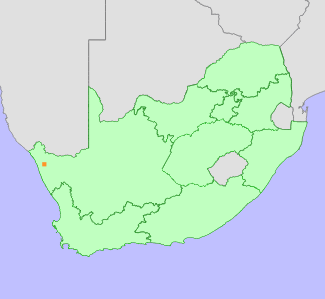|
Scientific Name | Conophytum chrisocruxum S.A.Hammer |
Higher Classification | Dicotyledons |
Family | AIZOACEAE |
National Status |
Status and Criteria | Critically Endangered A4d; B1ab(v)+2ab(v) |
Assessment Date | 2021/11/17 |
Assessor(s) | A.J. Young, P.G. Desmet, I. Ebrahim, D. Guo, A. Harrower, L. Jabar, L. Knoetze, C. Rodgerson, P.C.V. Van Wyk & N.N. Mhlongo |
Justification | This dwarf succulent species is endemic to the Northern Cape province of South Africa where it is only recorded from a single locality with an extent of occurrence (EOO) and area of occupancy (AOO) of 4 km2. It has been increasingly targeted by illegal collection in recent years and is in high demand by collectors. The majority (80-90%) of mature individuals from the only known population have been illegally collected for the trade in ornamental succulents since 2019. The continued threat of illegal collection remains very high with the single location rendering the species highly susceptible to further rapid decline due to this activity. Climate change is also highly likely to impact the population although there is uncertainty of the response given the expected resilience of this taxon. It therefore qualifies as Critically Endangered under criteria A4 and B1+2. |
Distribution |
Endemism | South African endemic |
Provincial distribution | Northern Cape |
Range | This species is endemic to a small part of the Northern Cape province of South Africa where it is only found in a single location with a severely restricted geographic range. |
Habitat and Ecology |
Major system | Terrestrial |
Major habitats | Namaqualand Klipkoppe Shrubland |
Description | This species is known from a single severely range restricted location in the Namaqualand Hardeveld bioregion of the Succulent Karoo biome. The plants typically form large clusters on large outcrops of quartz, where they lie within sheltered positions in cracks and crevices. This species has a generation length of 30 years. It is expected to be sensitive to the impacts of climate change as it does not disperse and while adapted to arid conditions, is dependent on limited seasonal rainfall. Species in the genus are sensitive to long periods of drought. Drought related mortality has been observed for other closely related taxa within the genus. |
Threats |
| This species is currently threatened by illegal collection for the international trade in ornamental succulents with over 80% of the population removed from habitat since 2019. The plants are severely range-restricted which renders them highly susceptible to further rapid decline in number through collection or other adverse events.
Anthropogenic climate change is a long-term threat to this species. While it is not possible to model the response of this species to climate change due to its restricted distribution, the average loss to climate change for 15 more widely distributed Conophytum species occurring within the same region is used as an indication of likely impact to this species. Climate models for the likely emission scenarios where emissions stay at present day levels (RCP 2.6) (Hausfather and Peters 2020) and worst case scenarios where emissions continue to increase during the 21st century (RCP 8.5) indicate that there will be a loss of suitable bioclimatic envelope of between 72% and 99% by 2080 for Conophytum taxa within the region. However, as this taxon occurs in a very sheltered habitat it is expected to have a level of resilience to climate change and the expected population loss is reduced by 20% to 52%. Species in this genus have limited dispersal ability and migration to suitable habitats elsewhere is regarded as highly unlikely. |
Population |
This species has been subject to illegal collection for the ornamental succulent trade since 2019. A recent assessment by SANBI (field survey in 2021) recorded only 300-500 mature individuals in habitat with evidence of another poaching event taking place since the site survey meaning that there are likely to be fewer than 500 individuals left in the wild at the time of this assessment. There was no formal population assessment prior to this but estimates by authorities on the genus suggest that approx. 1,500-2,500 mature individuals were present at the location prior to 2019. The population has therefore experienced a decline of more than 80% since 2019. Decline is ongoing due to sustained demand from collectors as well as adverse impacts from climate change.
|
Population trend | Decreasing |
Assessment History |
Taxon assessed |
Status and Criteria |
Citation/Red List version | | Conophytum chrisocruxum S.A.Hammer | CR B1ab(v)+2ab(v) | 2020.1 | | Conophytum chrisocruxum S.A.Hammer | VU D1+2 | 2017.1 | | Conophytum chrisocruxum S.A.Hammer | Least Concern | Raimondo et al. (2009) | |
Bibliography |
Hammer, S. 2002. Dumpling and his wife: New view of the genus Conophytum. EAE Creative Colour, Norwich.
Hammer, S.A. 1993. The genus Conophytum: A conograph. Succulent Plant Publications, Pretoria.
Hausfather, Z. and Peters, G.P. 2020. Emissions - the 'business as usual' story is misleading. Nature 577(618-620).
|
Citation |
| Young, A.J., Desmet, P.G., Ebrahim, I., Guo, D., Harrower, A., Jabar, L., Knoetze, L., Rodgerson, C., Van Wyk, P.C.V. & Mhlongo, N.N. 2021. Conophytum chrisocruxum S.A.Hammer. National Assessment: Red List of South African Plants version 2024.1. Accessed on 2025/12/30 |
 Comment on this assessment
Comment on this assessment


